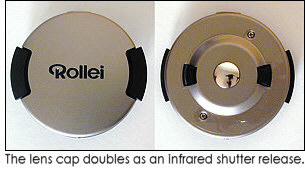 If you're going
to go to the trouble of producing a top-shelf camera, you can't just
stick any piece of mass-market lens to the front of it.
If you're going
to go to the trouble of producing a top-shelf camera, you can't just
stick any piece of mass-market lens to the front of it.
Rollei didn't skimp when it came to the lens for the Rollei QZ 35T. The S-VarioApogon is an extremely sharp lens, containing 10 elements in eight groups and is multicoated using Rollei's proven HFT (High Fidelity Transfer) process. The autofocus is quick and unobtrusive. The lens barrel again is constructed of titanium, matching the rest of the camera.
Photos were sharp with good corner to corner resolution. There is some light falloff in the corners, particularly at the widest focal length. You'll see it in some photos that have a lot of sky or other large single-tone regions. In most photos, you won't notice.
Distortion is well controlled. There is slight barrel distortion at 38mm. I didn't notice any pincushion distortion at the 90mm setting.
The focal length is displayed momentarily in the top deck's LCD display when you press either the "wide" or "tele" rocker switch. I would have like to have seen the focal length also displayed in the viewfinder.
Zoom speed is about average, but on the noisy side. It's not a terrible racket, but moving from wide angle to telephoto isn't silent. The camera doesn't focus continuously -- only when the user presses the shutter release.
 Like most of these systems, the autofocus has trouble in some situations.
Curiously, it had no problems in a room lit only by candles. But it
couldn't find a focus point on a foggy day, nor could it find infinity focus
when I was trying to take a photo of some interesting cloud formations.
For these photos, it was easier to switch the camera into manual-focus mode and
set the lens to infinity. If you do this, remember to reset the camera, or all
of your photos will be focused to infinity.
Like most of these systems, the autofocus has trouble in some situations.
Curiously, it had no problems in a room lit only by candles. But it
couldn't find a focus point on a foggy day, nor could it find infinity focus
when I was trying to take a photo of some interesting cloud formations.
For these photos, it was easier to switch the camera into manual-focus mode and
set the lens to infinity. If you do this, remember to reset the camera, or all
of your photos will be focused to infinity.
The subject will see a small red light, which makes it a little difficult to take photos unobtrusively. In daylight, the light isn't as noticeable.
Focusing manually, as I mention in another section, works but requires time and patience. The sensor is so sensitive that a small nudge of the wheel means the difference between achieving focus and being out of focus, or so the viewfinder would indicate.
Apertures are in full-stop increments. You can set the aperture dial between stops, but as far as I can tell, the camera uses the nearest full stop.
The autofocus system is located in the viewfinder housing, so it remains possible for you to take a photo with the lens cap still on the camera, despite the blinking "CAP" warning, which you should see but sometimes don't. But that's the fault of the photographer, not the camera.
 The
lens cap doubles as an infrared remote shutter release. It's great for family
portraits, and here's why: Most self-timers have a 10-second delay. That's too
much time. With the infrared remote, you tell everyone to be ready. Then you
press the button on the underside of the cap, and you have two seconds to hide
it before the camera fires. That keeps everyone from having to hold their grin
for 10 seconds.
The
lens cap doubles as an infrared remote shutter release. It's great for family
portraits, and here's why: Most self-timers have a 10-second delay. That's too
much time. With the infrared remote, you tell everyone to be ready. Then you
press the button on the underside of the cap, and you have two seconds to hide
it before the camera fires. That keeps everyone from having to hold their grin
for 10 seconds.
Yes, most users are correct in saying that the lens cap is too loosely sprung and is in constant danger of falling off. I'm going to buy an aftermarket lens cap and keep this in the bag. I've thought of tethering it to the camera, but I don't want to attach the sticky foam to the cap. On my Nikon, I'm more than happy to do that. Not with this camera though.
One last thing: The manual-focus dial is marked in meters. Possibly, the models produced for the U.S. market were in feet.